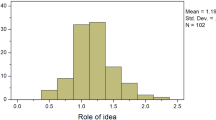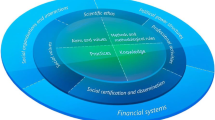Abstract
The article builds upon a study where students’ relations to science are related to their worldviews and the kind of worldviews they associate with science. The aim of the study is to deepen our knowledge of how worldview and students’ ways to handle conflicts between their own worldview and the worldview they associate with science, can add to our understanding of students’ relations to science. Data consists of students’ responses to a questionnaire (N = 47) and to interviews (N = 26). The study shows that for students who have a high ability in science, those who have taken science-intense programmes in upper secondary school to a higher extent than others have worldviews in accordance with the worldviews they associate with science. This indicates that students who embrace a worldview different from the one they associate with science tend to exclude themselves from science/technology programmes in Swedish upper secondary school. In the article the results are presented through case studies of single individuals. Those students’ reasoning is related to the results for the whole student group. Implications for science teaching and for further research are discussed.


Similar content being viewed by others
Notes
Scientism can be defined in a number of different ways (see Stenmark 2001). The definition used here follows Poole (1998). He states that scientism but not science “Denies that anything other than the natural world exists”, states that “Scientific accounts are all there are”, “Denies that there are first causes or final causes”, and “Denies that there could ever be behavior other than law like (anti-miraculous)” (Poole 1998, p. 195). This definition of scientism is similar to what Stenmark (2001) calls “Ontological Scientism”.
“Few conflicts” is defined as less than the 25% quartile—that is less than 5 conflicts.
“Many conflicts” is defined as more than the 75%-quartile—that is more than 12 conflicts.
With the “project of science” we mean the belief shared by researchers, that knowledge about the world is possible to gain and is worth the efforts. Also a belief in that knowledge is possible to gain through methodological reductionistic approaches.
Translations from Swedish by the authors.
References
Aikenhead, G. S. (1996). Science education: Border crossing into the subculture of science. Studies in Science Education, 27, 1–52.
Aikenhead G. S. (2006). Science education for everyday life. Evidence-based practice. Teachers College Press.
Alters, B. J. (1997). Whose nature of science? Journal of Research in Science Teaching, 34(1), 39–55.
Arlebrand, Hermansson and Wallin (2003) Ny tid ny tro?: Nyandliga rörelser och riktningar i dagens samhälle. [New time new beliefs?: New religious movements and directions in society of today] Gleerup, Malmö.
Baker, D., & Taylor, P. C. S. (1995). The effect of culture on the learning of science in non-western countries: The results of an integrated research review. International Journal of Science Education, 17(6), 695–704.
Brewer, W. F., & Chinn, C. A. (1991). Entrenched beliefs, inconsistent information, and knowledge change. In L. Birnbaum (Ed.), The international conference of the learning sciences: Proceedings of the 1991 Conference Charlottesville, Virginia: Association for the Advancement of Computing in Education (pp. 67–73).
Brickhouse, N. W. (2001). Embodying science: A feminist perspective on learning. Journal of Research in Science Teaching, 38(3), 282–295.
Brickhouse, N. W., Lowery, P., & Schultz, K. (2000). What kind of a girl does science? The construction of school science identities. Journal for Research in Science Teaching, 37(5), 421–458.
Cobern, W. W. (1991). World view theory and science education research. NARST Monograph No. 3. Manhattan, KS: National Association for Research in Science Teaching.
Cobern, W. W. (1993). College Students’ conceptualizations of nature: An interpretive world view analysis. Journal of Research in Science Teaching, 30(8), 935–951.
Cobern, W. W. (1996). Worldview theory and conceptual change in science education. Science Education, 80(5), 579–610.
Cobern, W. W. (2000a). Everyday thoughts about nature. Dordrecht: Kluwer Academic Publishers.
Cobern, W. W. (2000b). The nature of science and the role of knowledge and belief. Science & Education, 9, 219–246.
Cobern, W. W., & Aikenhead, G. S. (1998). Cultural aspects of learning science. In H. J. Fraser & K. G. Tobin (Eds.), The international handbook of science education (pp. 39–52). Dordrecht: Kluwer.
Cobern, W. W., & Loving, C. C. (2000). Defining “Science” in a multicultural world: Implications for science education. Science Education, 85, 50–67.
Costa, V. B. (1995). When science is “Another World”: Relationships between worlds of family, friends, school, and science. Science Education, 79(3), 313–333.
Dagher, Z. R., & BouJaoude, S. (1997). Scientific views and religious beliefs of college students: The case of biological evolution. Journal of Research in Science Teaching, 34(5), 429–445.
EU. (2004). Europe needs more scientists. Report by the High Level Group on Increasing Human Resources on Science and Technology in Europe from http://ec.europa.eu/research/conferences/2004/sciprof/pdf/final_en.pdf. Accessed 20 Feb 2009.
EU. (2005). Science and Society Portal of the European Commision. Retrieved 2009-02-20 from http://ec.europa.eu/research/conferences/2004/sciprof/pdf/final_en.pdf.
Gardner, P. L. (1975). Attitudes to science: A review. Studies in Science Education, 2, 1–41.
Gauch, H. G., Jr. (2009). Science, worldviews, and education. Science & Education, 18, 667–695.
Glennan, S. (2009). Whose science and whose religion? reflections on the relations between scientific and religious worldviews. Science & Education, 18, 797–812.
Hammer O. (2004). På spaning efter helheten. NEW AGE en ny folktro? Wahlström & Widstrand.
Hansson, L. (2007). “Enligt fysiken eller enligt mig själv?” – Gymnasieelever, fysiken och grundantaganden om världen. (“According to physics or according to myself?” – Upper secondary students, physics, and presuppositions about the world) (Diss., Studies in Science and Technology Education No 13), Linköping University. http://liu.diva-portal.org/smash/record.jsf?searchId=1&pid=diva2:17293.
Hansson, L., & Redfors, A. (2006a). Swedish upper secondary students’ views of the origin and development of the universe. Research in Science Education, 36, 355–379.
Hansson, L., & Redfors, A. (2006b). Tre elever berättar om universum, gud och fysiken. Nordina, 1/06, 31–43.
Hansson, L., & Redfors, A. (2007a). Physics and the possibility of a religious view of the universe: Swedish upper secondary students’ views. Science & Education, 16, 461–478.
Hansson, L., & Redfors, A. (2007b). Upper secondary students in group discussions about physics and our presuppositions of the world. Science & Education, 16, 1007–1025.
Härnqvist K. (1998). A longitudinal program for studying education and career development (Report 1998:01). Göteborg University: Department of Education and Educational Research.
Helve, H. (1991). The formation of religious attitudes and world views: A longitudinal study of young finns. Social Compass, 38(4), 373–392.
Jacobs, J. E., Simpkins S. D. (Eds.). (2005). Leaks in the pipeline to math, science, and technology careers: New directions for child and adolescent development. No. 110.
Jegede, O. J. (1995). Collateral learning and the eco-cultural paradigm in science and mathematics education in Africa. Studies in Science Education, 25, 97–137.
Kearney, M. (1984). World view. Novato, California: Chandler & Sharp Publishers, Inc.
Kilbourn, B. (1980). World views and science teaching. In: H. Munby, G. Orpwood, & T. Russell (Eds.), Seeing curriculum in a new light. Essays from Science Education. Toronta, Canada: OISE Press/The Ontario Institute for Studies in Education (pp. 34–43).
Kilbourn, B. (1980–1981). World views and curriculum. Interchange, 11(2), 1–10.
Krogh, L. B. (2005). Studying students’ attitudes towards science from a cultural perspective but with a quantitative methodology: Border crossing into the physics classroom. International Journal of Science Education, 27(3), 281–302.
Lacey, H. (2009). The interplay of scientific activity, worldviews and value outlooks. Science & Education, 18, 839–860.
Lemke, J. L. (2001). Articulating communities: Sociocultural perspectives on science education. Journal of Research in Science Teaching, 38(3), 296–316.
Lindahl, B. (2003). Lust att lära naturvetenskap och teknik? En longitudinell studie om vägen till gymnasiet. (Pupils’ responses to school science and technology? A longitudinal study of pathways to upper secondary school.) (Diss., Göteborg studies in educational sciences 196), Göteborg: Acta Universitatis Gothoburgensis English summary on http://gupea.ub.gu.se/dspace/handle/2077/9599.
Lindahl, B. (2007). A longitudinal study of students' attitudes towards science and choice of career. In Proceedings (CD) from NARST annual conference 2007, New Orleans, 15th–18th April.
Lindahl, B., & Hansson, L. (2009). Students’ presuppositions of what the world is like and their interest in choosing a science. In Proceedings (CD) from NARST annual conference 2009, Los Angeles, 17th–21th April.
Lyons, T. (2006). Different countries same science classes: Students’ experiences of school science in their own words. International Journal of Science Education, 28(6), 591–613.
Matthews, M. R. (2009a). Science, worldviews and education: An introduction. Science & Education, 18, 641–666.
Matthews, M. R. (2009b). Teaching the philosophical and worldview components of science. Science & Education, 18, 697–728.
National Agency for Education. (2000). The Swedish education system. Available from http://skolnet.skolverket.se/polopoly/utbsys-eng/Accessed 11 August 2009.
Osborne, J., & Dillon, J. (2008). Science education in Europe: Critical reflections. A report to the Nuffield foundation. Available from http://www.nuffieldfoundation.org/fileLibrary/pdf/Sci_Ed_in_Europe_Report_Final.pdf. Accessed 10 Jun 2009.
Osborne, J., Simon, S., & Collins, S. (2003). Attitudes towards science: A review of the literature and its implications. International Journal of Science Education, 25(9), 1049–1079.
Phelan, P., Davidson, A. L., & Cao, H. T. (1991). Students’ multiple worlds: Negotiating the boundaries of family, peer, and school cultures. Anthropology & Education Quarterly, 22, 224–250.
Poole, M. W. (1998). Science and science education: A judeo-christian perspective’. In W. W. Cobern (Ed.), Socio-cultural perspectives on science education. An international dialogue (pp. 181–201). Dordrecht: Kluwer Academic Publishers.
Proper, H., Wideen, M. F., & Ivany, G. (1988). World view projected by science teachers: A study of classroom dialogue. Science Education, 72(5), 547–560.
Reiss, M. (2009). Imagining the world: The significance of religious worldviews for science education. Science & Education, 18, 783–796.
Roberts, D. A. (1998). Analysing school science courses: The concept of companion meaning. In D. A. Roberts & L. Östman (Eds.), Problems of meaning in science curriculum (pp. 5–12). New York: Teacher College Press.
Säther, J. (2003). The concept of ideology in analysis of fundamental questions in science education. A rewiew with selected examples from norwegian curricula and textbooks. Science & Education, 12, 237–260.
Schibeci, R. A. (1984). Attitudes to science: An update. Studies in Science Education, 11, 26–59.
Schreiner, C. (2006). EXPLORING A ROSE-GARDEN Norwegian youth’s orientations towards science—seen as signs of late modern identities Department of Teacher Education and School Development Faculty of Education University of Oslo.
Science & Education. (2009). 18(6–7). Special issue science, worldviews and education (M. R. Matthews (Ed.)).
Sjøberg, S., & Schreiner, C. (2005). Naturfag og teknologi i skole og samfunn: Interesse of rekruttering. [Science and technology in school and society. Interest in recruitment.] Utdanning.
Sjödin, U. (1995). En skola—flera världar. Värderingar hos elever och lärare i religionskunskap i gymnasieskolan. [One school—many worlds. Students’ and teachers’ values in religious education in upper secondary school] Bokförlaget Plus Ultra, Helsingborg.
Sjödin, U. (2001). Mer mellan himmel och jord? En studie av den beprövade erfarenhetens ställning bland svenska ungdomar [More under the sun? A study of learned experiences among Swedish youth] Verbum, Stockholm.
Sjödin, U. (2002). Övertron på övertron och den sekulariserade ungdomens religiositet [Superstition on superstion and the religiousness of the secularized youth] In O. Franck (Ed.), Mellan vidskepelse och vetenskap. Att tro, att tvivla—och att veta. [Between superstition and science. To believe, to doubt—and to know.] Föreningen lärare i religionskunskap. Årsbok 2002, Årg 34.
Stenmark, M. (2001). Scientism: Science, ethics and religion. Aldershot: Ashgate Science and Religion Series.
Stenmark, M. (2004). How to relate science and religion: A multidimensional model. Grand Rapids, USA: Eerdmans.
Trusted, J. (1991). Physics and metaphysics: Theories of space and time. London and New York: Routledge.
Worthley, J. S. (1992). Is science persistence a matter of values? Psychology of Women Quarterly, 16, 57–68.
Author information
Authors and Affiliations
Corresponding author
Appendices
Appendix A
Appendix B
Appendix C
Rights and permissions
About this article
Cite this article
Hansson, L., Lindahl, B. “I have chosen another way of thinking”. Sci & Educ 19, 895–918 (2010). https://doi.org/10.1007/s11191-010-9275-6
Published:
Issue Date:
DOI: https://doi.org/10.1007/s11191-010-9275-6




